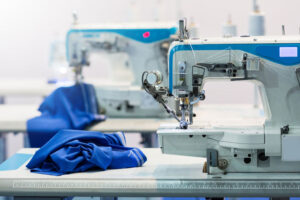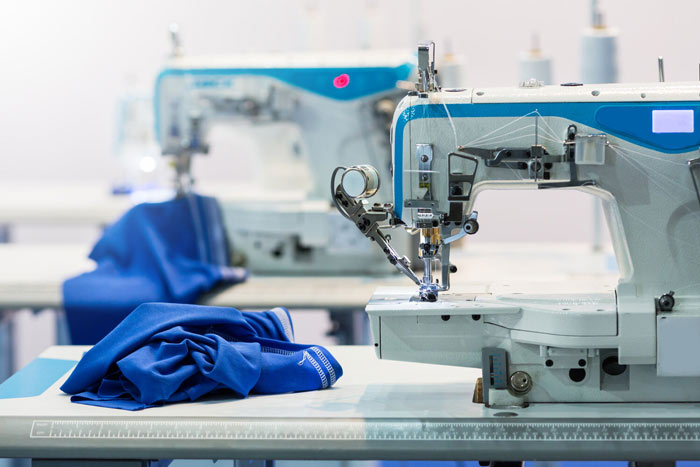When it comes to sewing machines of the industrial variety, say hello to a wide assortment of models.
 However, don’t worry, there’s no space for redundancy here. All of these machines differ from the next and serve a unique purpose.
However, don’t worry, there’s no space for redundancy here. All of these machines differ from the next and serve a unique purpose.
In this segment, I’ll take you through the ten types of Industrial sewing machine and their uses.
Let’s get right into it!
1. Overlock Sewing Machine
With the ability to accommodate three different types of threads, the overlock sewing machine is proficient in working with a multitude of stitches. Plus, they’re also easy to operate.
Uses: This type is used primarily for garment panels and knitted garment sewing. Furthermore, you can also use the overlock sewing machine to handle side seams on your T-shirts.
2. Feed Off the Arm machine
A bit rare for household use, the FOA is a pretty common tool in the industry and is designed just like the standard industry-based machine with no major structural difference.
Uses: The main purpose of this machine is to tackle flat seams, and in doing so, can effectively handle sewing side seams for your shirt or the underarms. Furthermore, the FOA can also sew jeans inseams, which is mostly its niche target.
3. Buttonhole Machine
One of the most common types of industrial sewing machines, the buttonhole machine is utilized for punching holes in your garment. Yes, the task is specialized and carried out by a particular utility.
Uses: The main use for this machine is that with it, you can sew buttonholes with different stitch densities, which can result in different qualities.
4. Zigzag Sewing Machine
The zigzag sewing machine is pretty self-explanatory and is good at making a very particular pattern.
Uses: As the name implies, a zigzag sewing machine is proficient in making sewing patterns that appear in a zigzag shape.
They can effectively be used on any garment that requires this pattern but is most notably used for the sewing of bras, jacket, and other clothes that require extra attention to detail.
5. Double-Needle Lock Stitch Machine
A double-needle lock stitch machine has two needles that puncture simultaneously, as opposed to the traditional machine with only one needle working.
Uses: Fast and efficient, the main purpose of the double-needle lock stitch machine is to provide two stitches to ensure extra reliability and strength.
6. Single-Needle Lock Stitch Machine
The single-needle locks stitch is one of the most prevalent models on this list, and I’d frankly recommend it if you’re looking for something with excellent versatility. It also features computerized programs.
Uses: The main purpose of this model is to join two different fabrics together. This can be done regardless of the type of fabric used, and hence, is a testament to the versatility.
7. Flatlock Sewing Machine
Flatlock sewing machines come with about 2 or 3 needles and, like the predecessor, can also handle various types of sewing jobs with ease. Furthermore, they also come in two main types, which are namely flatbed and cylinder bed.
Uses: The main use of flatlock sewing machines is that they help in hemming sleeves and the bottom of knit products. On top of that, you can also use this type of machine for design, but it might take more time and effort.
8. Button Attaching Machine
As the name implies, the button attaching machine is virtually as simple as it gets and is geared for a singular task only.
Uses: With the prime objective of sewing on buttons, this machine is highly specific and serves one main purpose only, so that’s one point off of versatility.
However, it’s fair to say that you can literally deal with every type of button with this machine, and the process is fairly automatic.
9. Bartack Machine
Like the button attaching machine, the bartack machine is also very specific and functions as a singular task only.
Uses: The main purpose that this type of machine serves is to reinforce seams and garment components.
The principle dictates that any and every type of bartaking task can be executed to perfection by this machine, which is something you can’t do with other machines.
10. Multi-Needle Chain Stitch Machine
As the name implies here, multiple needles are employed at the same time and function simultaneously. It’s a little hard to operate, but once you get the hang of it, this machine can significantly cut down on the total time spent.
Uses: This type of sewing machine is best used for smocking operation and pin-tuck operation.
Conclusion
I hope that the information above helped you get a better idea of what’s available these days, and what you can make. If you have any feedback or suggestions, feel free to share them in the comment section below!
Read Also:

